Ichthyofaunal community assemblage and spatiotemporal patterns in the Bons Sinais Estuary, Mozambique: Ecological drivers and conservation implications
IF 2.1
4区 环境科学与生态学
Q3 ECOLOGY
引用次数: 0
Abstract
Understanding the ichthyofaunal assemblage of estuarine and adjacent coastal ecosystems is important for managing fishery resources and implementing conservation actions. This study explored the structure, diversity, and spatial-temporal variations of the ichthyofauna in the Bons Sinais Estuary (Mozambique) and the influence of environmental parameters. Fish sampling was conducted in the lower, middle, and upper zones using beach seine (active) and chicocota (fixed) gears in January 2020 and monthly from July 2020 to June 2021. The study identified 102 fish species, mostly of marine origin, belonging to 51 families. The most abundant families were Sciaenidae, Engraulidae, Clupeidae, Mugilidae, and Gobiidae, contributing over 78 % of the total catch. The most dominant species were Thryssa vitrirostris, Johnius dussumieri, Johnius dorsalis, Sardinella albella, Mugil cephalus, and Hilsa kelee, which accounted for more than half (52.43 %) of the abundance and 48.27 % of the biomass. The study found an ichthyofaunal community characterised by significant spatial variations, primarily influenced by salinity. The dominance of marine species in the lower and middle estuary contrasted with freshwater species in the upper zone. Dominant species showed spatial variations in abundance and biomass, but fewer showed seasonal variations. The middle estuary exhibited the highest species richness, diversity, and average abundance, while the lower zone had the highest biomass average. Threatened species, including Oreochromis mossambicus, comprised 3.4 % of the total abundance. These findings highlight the need for sustainable exploitation of fisheries resources and preserving the ecological functions of the Bons Sinais Estuary, which is important for resident and migratory species.
莫桑比克Bons Sinais河口鱼类群落组合与时空格局:生态驱动因素与保护意义
了解河口和邻近沿海生态系统的鱼类种群组合对渔业资源管理和实施养护行动具有重要意义。本研究探讨了莫桑比克Bons Sinais河口鱼类区系的结构、多样性、时空变化及环境参数的影响。在2020年1月和2020年7月至2021年6月期间,每月分别使用海滩围网(活动)和chicocota(固定)装置在下、中、上层区域进行鱼类取样。该研究确定了102种鱼类,其中大部分来自海洋,属于51科。捕集数量最多的科为棘鱼科、棘鱼科、棘鱼科、麻鱼科和棘鱼科,占总捕集量的78. %以上。优势种为镜翅蓟马(Thryssa vitrirostris)、dussumieri、Johnius dorsalis、salella albella、Mugil cephalus和Hilsa kelee,占总丰度的一半以上(52.43 %)和生物量的48.27 %。该研究发现了一个主要受盐度影响的鱼系群落,其特征是显著的空间变化。河口中下游以海洋物种为主,上游以淡水物种为主。优势种的丰度和生物量存在空间差异,而季节差异较少。河口中部的物种丰富度、多样性和平均丰度最高,而河口下游的平均生物量最高。受威胁物种占总丰度的3.4 %,其中包括莫sambicus。这些发现强调了可持续开发渔业资源和保护bonssinais河口生态功能的必要性,这对常驻和迁徙物种至关重要。
本文章由计算机程序翻译,如有差异,请以英文原文为准。
求助全文
约1分钟内获得全文
求助全文
来源期刊

Regional Studies in Marine Science
Agricultural and Biological Sciences-Ecology, Evolution, Behavior and Systematics
CiteScore
3.90
自引率
4.80%
发文量
336
审稿时长
69 days
期刊介绍:
REGIONAL STUDIES IN MARINE SCIENCE will publish scientifically sound papers on regional aspects of maritime and marine resources in estuaries, coastal zones, continental shelf, the seas and oceans.
 求助内容:
求助内容: 应助结果提醒方式:
应助结果提醒方式:


